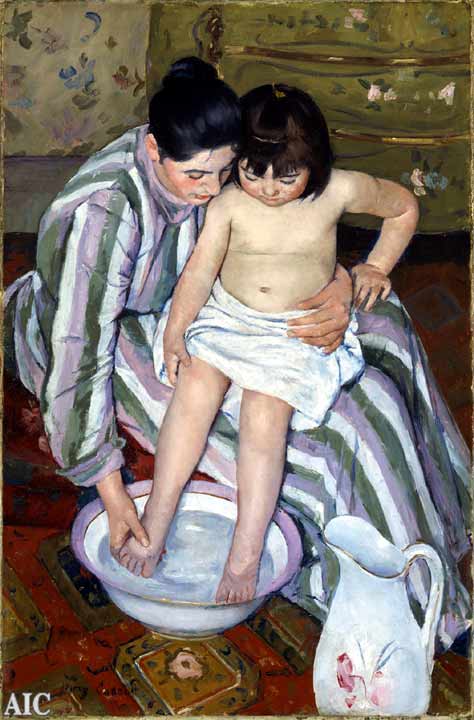Mary Cassatt Gallery
Oil on canvas 100.3 x 66 cm
Mary Cassatt was the only American to exhibit with the original Impressionist group. Like her friend Degas, she was a highly skilled draftsman who preferred unposed, asymmetrical compositions. In The Child's Bath, the circular shapes of the figures’ heads, the basin, and the pitcher, as well as the striped pattern of the woman’s dress animate the portrait of a woman bathing a child. Cassatt’s unusual vantage point (from above) as well as her choice of a female subject show her interest in Japanese woodblock prints, which had become extremely popular in France at the time.
The theme of women caring for children appeared frequently in Cassatt’s art during and after the 1880s. In rendering this subject, the artist relied on keen observation rather than idealization, but still portrayed great intimacy. The woman’s gestures — one firm hand securing the child in her lap, the other gently caressing its small foot — are both natural and emblematic, communicating her tender concern for the child’s well-being. The two figures gaze in the same direction, looking together at their paired reflection in the basin of water.
The many paintings, pastels, and prints in which Cassatt depicted children being bathed, dressed, read to, held, or nursed reflect the most advanced 19th-century ideas about raising children. After 1870, French scientists and physicians encouraged mothers (instead of wet-nurses and nannies) to care for their children and suggested modern approaches to health and personal hygiene, including regular bathing. In the face of several cholera epidemics in the mid-1880s, bathing was encouraged not only as a remedy for body odors but as a preventative measure against disease.
http://digitalconsciousness.net/top sites/?iy=311

viewer |
|
|
| Breakfast |
Bath |
| Boating Party |
| Arranging Her Hair |
| Black Hat |
| Family |
| Dancer |
Biography
Bulletin Board
Renowned Art
(home)
Cassatt was born in Pittsburg and attended the Pennsylvania Academy of the Fine Arts in Philadelphia. She traveled extensively through Europe with her parents and siblings and in 1874 she settled permanently in Paris. Although she had several works accepted for exhibition by the tradition-bound French Salon, her artistic aims aligned her with the avant-garde painters of the time and in 1877 she joined the impressionists. Her innovative compositions explore the lives of women - attending the opera, drinking tea, writing letters, caring for children in a straightforward manner free from sentimentality. She created an ambitious mural representing modern woman for the 1893 World's Fair.
all artists, with thumbnails: by birth year | alphabetically
all artists: by birth year | alphabetically
artists born in the 13th 14th 15th 16th 17th 18th 19th 20th century